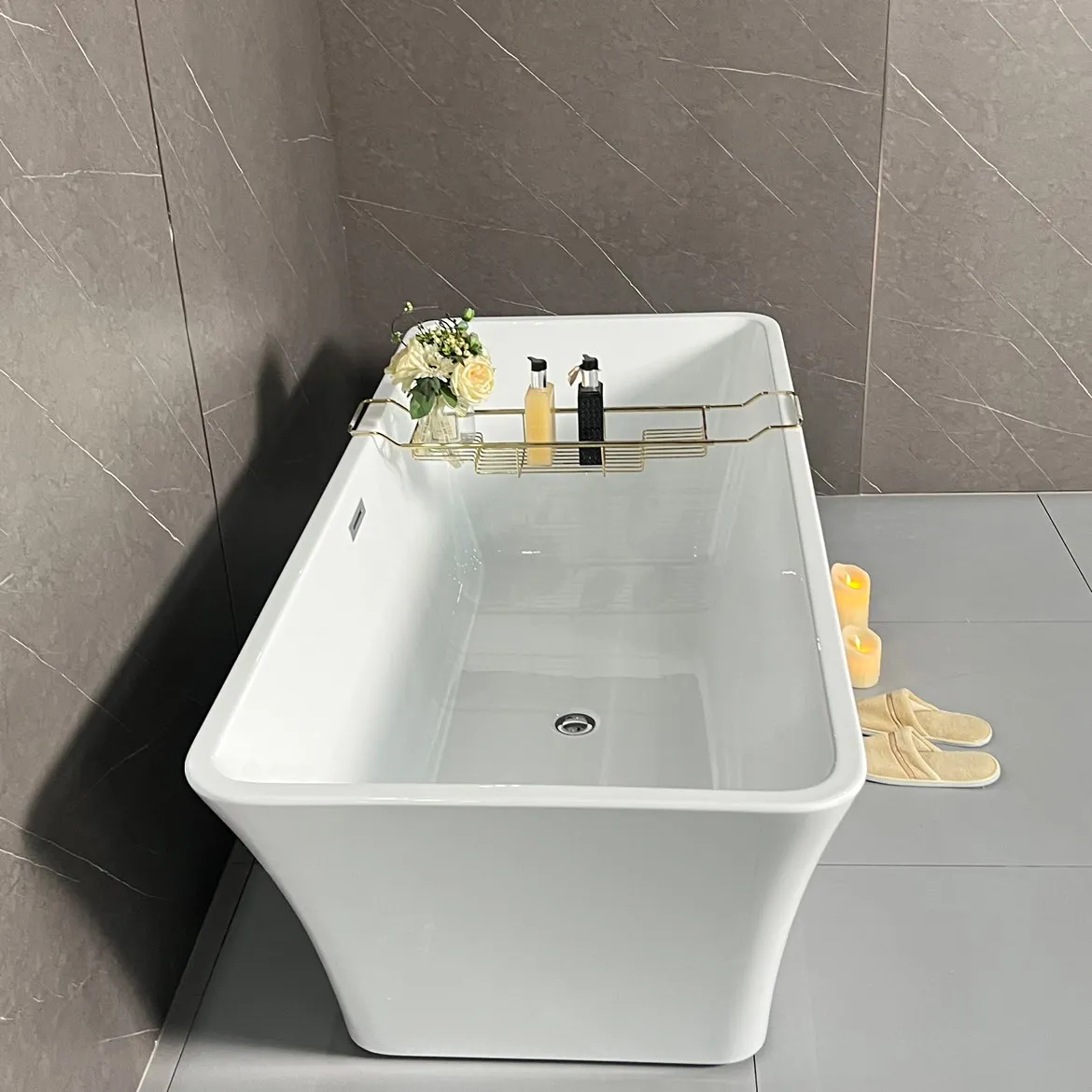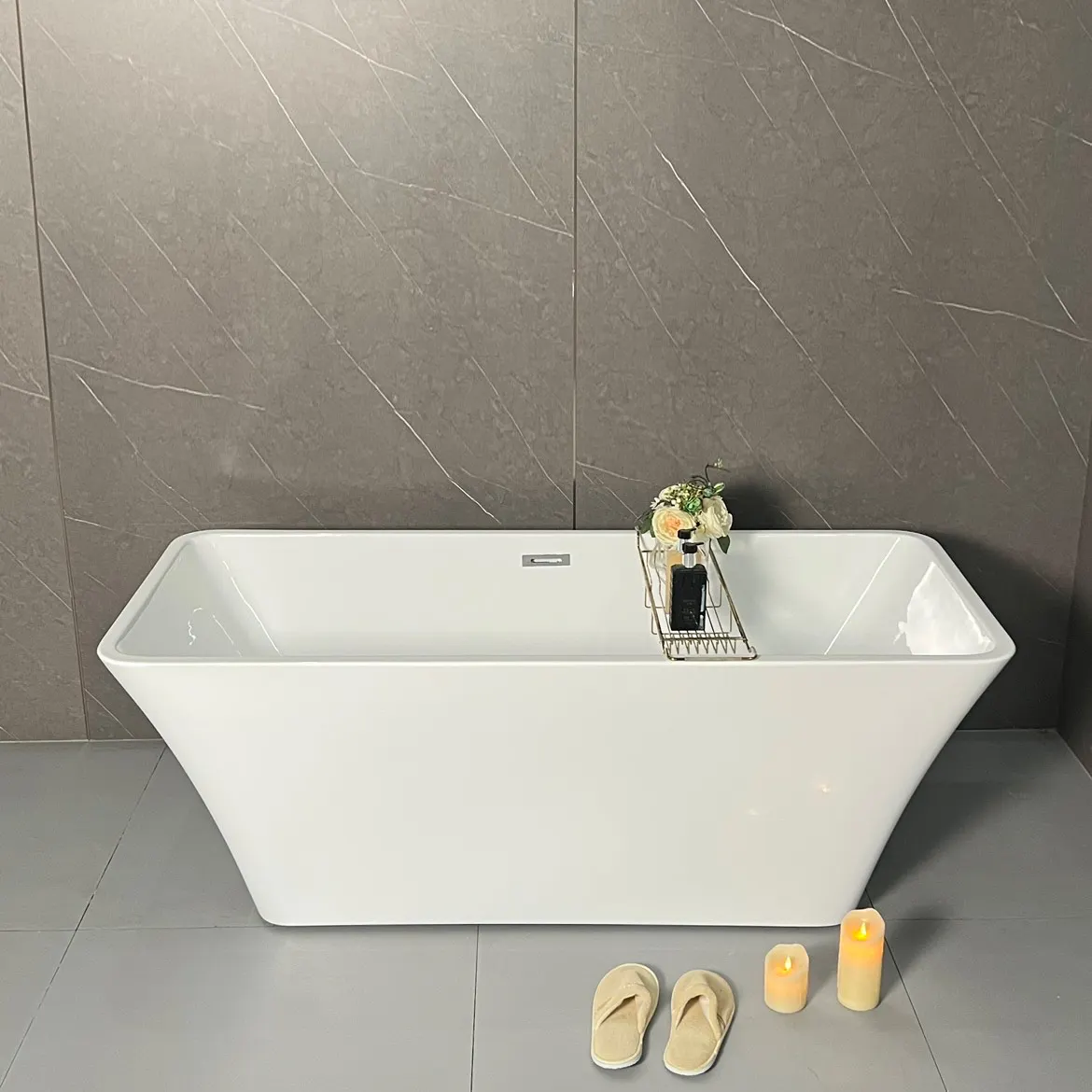Lựa Chọn Vật Liệu Bồn Tắm Phù Hợp Với Lối Sống Của Bạn
Lựa chọn lý tưởng bồn tắm việc lựa chọn vật liệu là một bước quan trọng trong việc thiết kế phòng tắm đáp ứng nhu cầu chức năng và thẩm mỹ của bạn. Với nhiều loại vật liệu khác nhau có sẵn trên thị trường, mỗi loại đều có những ưu điểm riêng, việc đưa ra quyết định sáng suốt có thể ảnh hưởng đáng kể đến sự thoải mái, quy trình bảo dưỡng và cả ngân sách của bạn. Hướng dẫn này sẽ khám phá sáu loại bồn tắm vật liệu phổ biến thường được sử dụng trong các ngôi nhà hiện đại, phân tích độ bền, mức độ dễ dàng trong bảo trì, chi phí và mức độ phù hợp tổng thể cho việc sử dụng hàng ngày.
Bồn Tắm Acrylic
Nhẹweight và Dễ dàng cài đặt
Bồn tắm bằng nhựa acrylic là lựa chọn phổ biến của nhiều chủ nhà đang tìm kiếm sự cân bằng giữa hiệu quả kinh tế và phong cách hiện đại. Nhờ trọng lượng nhẹ, chúng dễ dàng vận chuyển và lắp đặt, thường không cần đến các hệ thống hỗ trợ cấu trúc bổ sung. Vật liệu này đặc biệt phù hợp cho các phòng tắm ở tầng hai hoặc các dự án cải tạo.
Khả năng giữ nhiệt và sự linh hoạt
Một trong những đặc điểm nổi bật của bồn tắm acrylic là khả năng giữ nhiệt tốt, mang lại trải nghiệm tắm ấm áp và thư giãn. Ngoài ra, chất liệu acrylic rất linh hoạt về hình dạng và thiết kế, cho phép tùy chỉnh để phù hợp với nhiều kiểu bố trí và phong cách phòng tắm khác nhau. Bề mặt mịn và không thấm nước cũng giúp chống lại sự phát triển của nấm mốc và vết bẩn.
Bồn Tắm Bằng Gang Đúc
Độ bền và tuổi thọ vượt trội
Bồn tắm bằng gang đúc được biết đến với độ bền và chất lượng lâu dài. Được phủ một lớp men, những chiếc bồn này có thể chịu được việc sử dụng thường xuyên trong nhiều năm mà không bị mất đi vẻ bóng đẹp ban đầu. Thiết kế chắc chắn của chúng cũng rất lý tưởng cho những chủ nhà đề cao độ bền và vẻ đẹp cổ điển truyền thống.
Giữ nhiệt xuất sắc
Bồn tắm bằng gang đúc có khả năng giữ nhiệt tuyệt vời, điều này có nghĩa là nước sẽ giữ ấm trong thời gian dài hơn. Tuy nhiên, trọng lượng lớn của chúng thường đòi hỏi sàn nhà phải được gia cố và lắp đặt bởi chuyên gia, khiến chúng ít phù hợp với phòng tắm ở tầng cao trừ khi đã thực hiện các điều chỉnh cần thiết.
Bồn tắm bằng sợi thủy tinh
Tiết kiệm chi phí và nhẹ
Sợi thủy tinh cũng là vật liệu phổ biến khác được sử dụng trong sản xuất bồn tắm nhờ giá thành phải chăng. Các loại bồn tắm này tương đối nhẹ và dễ dàng lắp đặt, khiến chúng trở thành lựa chọn lý tưởng cho những chủ nhà quan tâm đến ngân sách hoặc các công trình cải tạo nhanh chóng.
Dễ bảo dưỡng nhưng độ bền thấp hơn
Mặc dù bồn tắm bằng sợi thủy tinh dễ làm sạch và bảo dưỡng, nhưng chúng thường kém bền hơn so với các lựa chọn khác. Vật liệu này dễ bị trầy xước và nứt theo thời gian, đặc biệt khi sử dụng thường xuyên. Tuy nhiên, đối với phòng tắm dành cho khách hoặc khu vực ít sử dụng, chúng vẫn là giải pháp thực tế.

Bồn tắm bằng thép tráng men Sứ
Kiểu dáng cổ điển với các lợi ích hiện đại
Bồn tắm bằng thép tráng men sứ kết hợp sự sang trọng của lớp phủ bóng với giá cả phải chăng của thép. Những chiếc bồn này thường được lựa chọn nhờ vẻ ngoài tinh tế, cổ điển và độ bền tương đối so với bồn làm bằng sợi thủy tinh hoặc nhựa acrylic.
Chống hóa chất và vết bẩn
Lớp men phủ trên bề mặt bồn tắm tạo ra một lớp không thấm nước, chống lại các hóa chất thường dùng trong nhà tắm và các vết ố. Tuy nhiên, bề mặt này có thể bị sứt mẻ nếu có vật nặng rơi trúng, làm lộ phần thép bên dưới và gây gỉ sét nếu không được sửa chữa kịp thời.
Bồn tắm bằng đá resin
Tính thẩm mỹ và chức năng cao cấp
Bồn tắm đá resin là lựa chọn sang trọng kết hợp giữa đá tự nhiên và vật liệu tổng hợp. Vật liệu lai này mang lại cảm giác chắc chắn như đá, đồng thời có bề mặt mịn và tinh tế, làm tăng giá trị thẩm mỹ cho bất kỳ phòng tắm nào.
Cách nhiệt tuyệt vời và khả năng tùy chỉnh
Đá resin nổi tiếng với khả năng giữ nhiệt và sự thoải mái tuyệt vời. Vật liệu này có thể được đúc thành nhiều hình dạng và kích thước khác nhau, khiến nó trở thành lựa chọn yêu thích của các nhà thiết kế muốn tạo ra những đặc điểm độc đáo và bắt mắt. Mặc dù đắt hơn so với các vật liệu khác, đá resin vẫn mang lại sự cân bằng tốt giữa vẻ đẹp và hiệu suất.
Bồn Tắm Đồng
Thiết Kế Đặc Trưng và Tính Chống Khuẩn
Bồn tắm đồng nổi bật nhờ màu sắc phong phú và vẻ ngoài được chế tác thủ công. Ngoài giá trị thẩm mỹ, đồng còn có tính kháng khuẩn tự nhiên và chống lại nấm mốc, giúp những chiếc bồn này vừa đẹp vừa đảm bảo vệ sinh.
Bề Mặt Bền và Khả Năng Tự Phục Hồi
Một trong những đặc tính độc đáo của đồng là lớp hoàn thiện "sống", nghĩa là đồng có thể hình thành lớp patina tự nhiên theo thời gian. Những vết trầy xước nhỏ trên bề mặt bồn tắm đồng thường tự phục hồi, góp phần kéo dài tuổi thọ của vật liệu. Tuy nhiên, bồn đồng thường đắt hơn đáng kể và đòi hỏi quy trình vệ sinh cẩn thận để duy trì vẻ ngoài ban đầu.
Các Yếu Tố Cần Cân Nhắc Khi Lựa Chọn Vật Liệu Bồn Tắm
Tần suất sử dụng và mức độ lưu lượng
Hãy suy nghĩ về tần suất sử dụng bồn tắm và bởi ai. Ví dụ, các phòng tắm có lưu lượng sử dụng cao có thể sẽ được lợi từ những chất liệu bền hơn như gang đúc hoặc đá resin, trong khi phòng tắm dành cho khách có thể sử dụng chất liệu sợi thủy tinh hoặc acrylic mà không làm giảm chức năng sử dụng.
Yêu cầu bảo trì và vệ sinh
Mỗi chất liệu bồn tắm đi kèm với những yêu cầu bảo trì riêng. Acrylic và sợi thủy tinh tương đối dễ bảo trì nhưng có thể không tồn tại lâu dài. Gang đúc và đồng mang đến độ bền vượt trội nhưng đòi hỏi các sản phẩm và quy trình làm sạch đặc thù hơn.
Lựa chọn chất liệu phù hợp với thẩm mỹ phòng tắm
Sự hài hòa thiết kế và phong cách cá nhân
Bồn tắm của bạn không chỉ nên đáp ứng mục đích sử dụng thực tế mà còn phải hài hòa với thiết kế tổng thể của phòng tắm. Dù bạn yêu thích phong cách hiện đại, tối giản hay phong cách cổ điển, mang hơi hướng hoài cổ, thì cũng có loại vật liệu bồn tắm phù hợp với mong muốn của bạn. Chất liệu đá resin và đồng rất lý tưởng để tạo điểm nhấn ấn tượng, trong khi men sứ và acrylic mang lại vẻ đẹp truyền thống hơn.
Tùy Chọn Màu Sắc và Hình Dáng
Một số vật liệu như acrylíc và đá resin mang lại sự linh hoạt cao hơn về màu sắc và hình dáng. Điều này cho phép chủ nhà cá nhân hóa bồn tắm phù hợp hơn với không gian sẵn có và sở thích thẩm mỹ của họ.
Các yếu tố về môi trường và sức khỏe
Bền vững và thân thiện với môi trường
Đối với những chủ nhà quan tâm đến môi trường, việc lựa chọn bồn tắm làm từ vật liệu có thể tái chế hoặc bền vững là rất quan trọng. Đồng và đá resin, khi được cung ứng có trách nhiệm, có thể là lựa chọn thân thiện với môi trường. Ngoài ra, độ bền cao của chúng giúp giảm nhu cầu thay thế, góp phần giảm tác động đến môi trường.
An Toàn và Chất Lượng Không Khí Trong Nhà
Các bề mặt không thấm nước có trong các vật liệu như acryl và thép tráng men sứ có thể giúp ngăn ngừa sự phát triển của nấm mốc và vi khuẩn. Điều này góp phần tạo ra một môi trường phòng tắm sạch sẽ và lành mạnh hơn, đặc biệt quan trọng trong các gia đình có trẻ nhỏ hoặc người cao tuổi.
Chi phí và Đầu tư dài hạn
Chi phí ban đầu so với Độ bền
Mặc dù một số vật liệu làm bồn tắm như sợi thủy tinh có chi phí ban đầu thấp hơn, nhưng chúng có thể không mang lại giá trị dài hạn như bồn tắm bằng gang hoặc bồn làm từ nhựa đá. Khi lập ngân sách cho một bồn tắm mới, hãy cân nhắc không chỉ giá mua mà còn cả chi phí lắp đặt, bảo trì và tuổi thọ dự kiến của vật liệu.
Gia tăng giá trị tài sản
Đầu tư vào một bồn tắm chất lượng cao có thể làm tăng giá trị bán lại của ngôi nhà trang chủ . Người mua thường đánh giá cao những thiết bị bền đẹp như bồn tắm bằng nhựa đá hoặc bằng đồng, khiến chúng trở thành một lựa chọn thông minh cho những chủ nhà muốn nâng giá trị tài sản của mình.
Câu hỏi thường gặp
Vật liệu bồn tắm nào bền nhất?
Gang đúc thường được coi là vật liệu bồn tắm bền nhất nhờ cấu tạo chắc chắn và lớp men phủ có khả năng chống trầy xước và bong mẻ.
Vật liệu bồn tắm nào dễ vệ sinh nhất?
Chất liệu acryl và thép tráng men sứ là những vật liệu dễ vệ sinh nhất nhờ bề mặt mịn, không thấm nước, giúp chống lại nấm mốc và vết bẩn.
Có nên đầu tư vào bồn tắm bằng đá resin không?
Có, bồn tắm bằng đá resin mang lại vẻ ngoài sang trọng, khả năng giữ nhiệt tuyệt vời và độ bền lâu dài, khiến chúng là một khoản đầu tư đáng giá đối với nhiều chủ nhà.
Bồn tắm bằng đồng có cần bảo dưỡng đặc biệt không?
Bồn tắm bằng đồng cần được bảo dưỡng cẩn thận để giữ được lớp hoàn thiện. Sử dụng chất tẩy rửa dịu nhẹ và thói quen lau khô định kỳ sẽ giúp duy trì lớp oxit tự nhiên và ngăn ngừa hư hại.
Mục Lục
- Lựa Chọn Vật Liệu Bồn Tắm Phù Hợp Với Lối Sống Của Bạn
- Bồn Tắm Acrylic
- Bồn Tắm Bằng Gang Đúc
- Bồn tắm bằng sợi thủy tinh
- Bồn tắm bằng thép tráng men Sứ
- Bồn tắm bằng đá resin
- Bồn Tắm Đồng
- Các Yếu Tố Cần Cân Nhắc Khi Lựa Chọn Vật Liệu Bồn Tắm
- Lựa chọn chất liệu phù hợp với thẩm mỹ phòng tắm
- Các yếu tố về môi trường và sức khỏe
- Chi phí và Đầu tư dài hạn
- Câu hỏi thường gặp

